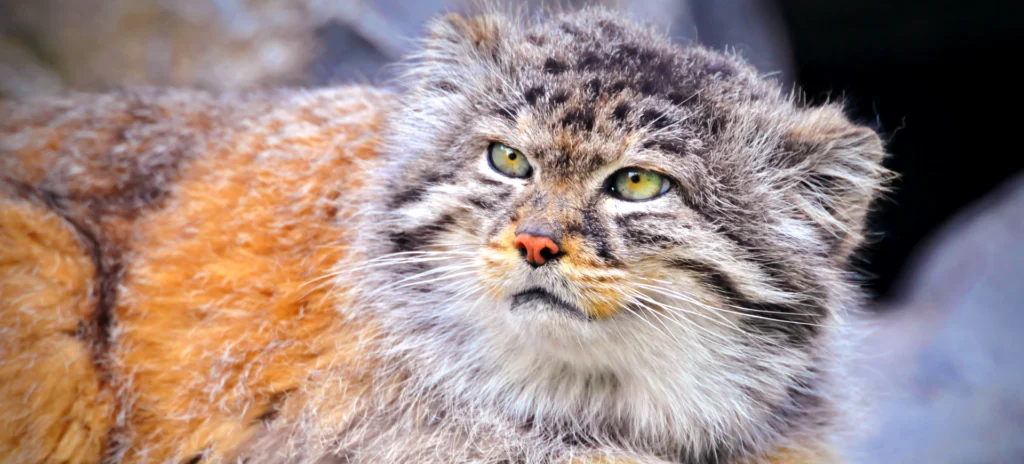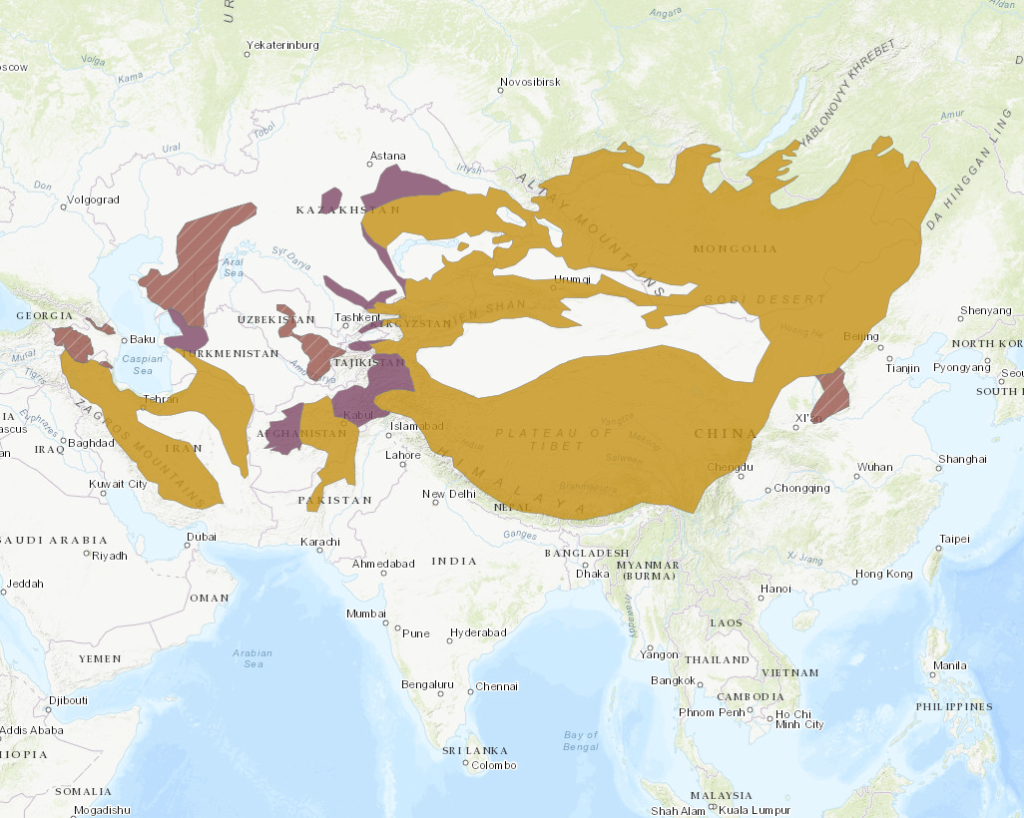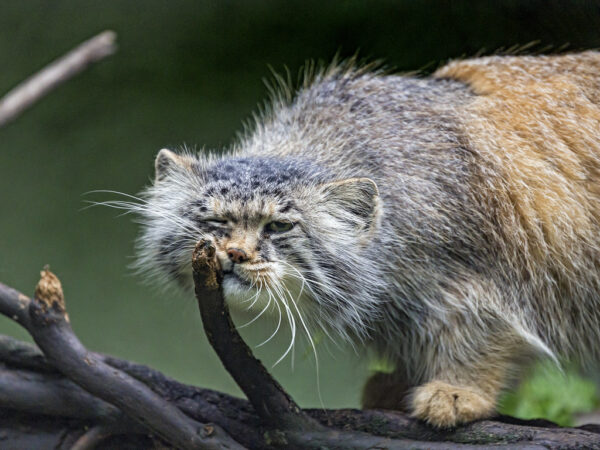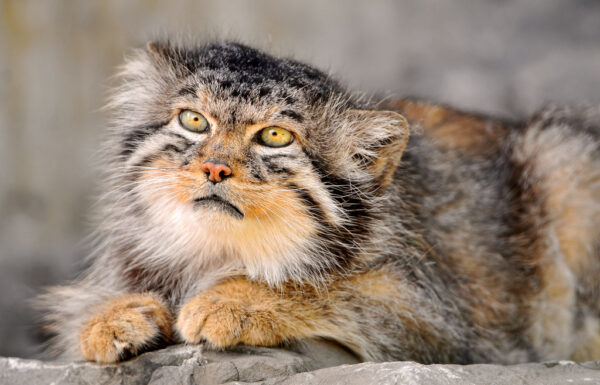The Pallas’s Cat, with its thick fur and low-slung ears, is masterfully adapted to the frigid climates of Central Asia. This article explores its unique biology, behavior, and the challenges it faces for survival in a rapidly changing world.
Key Takeaways
Pallas’s Cats are known for their distinctive features, such as dense fur, round features, and low-set ears. These features serve as adaptations to their cold habitats and help minimize exposure.
Habitat fragmentation due to human activities like overgrazing, agriculture, and infrastructure development poses a significant threat to Pallas’s Cats by isolating populations and limiting genetic diversity.
Conservation efforts are in place to protect Pallas’s Cats, listed as ‘Near Threatened. Organizations like PICA and Panthera focus on research, education, and field projects to encourage global awareness and promote species survival.
Distinctive Features of Pallas’s Cats

Pallas’s Cats, sometimes known simply as Pallas’s Cats, are characterized by several unique attributes that differentiate them from other feline family members. Among these characteristics are:
A robust and hefty physique
Fur that is long and thick
An appearance of both sturdy and fluffy
The illusion they give off being larger than reality
Comparable dimensions to domesticated house cats despite their more pronounced features
The coat of these enigmatic creatures, including the rare variant Pallas’s Cat, presents an enchanting intermixture of light grey mingled with soft yellowish-beige undertones. Seasonal variations see their fur change dramatically. Hair tips transition from shades akin to black to pure white between summer and winter, creating a stunning visual transformation.
In terms of facial structure, certain traits define the visage of a Pallas’s Cat:
Ears that curve inwardly positioned low on either side
The head of their head.
-A distinctly round skull shape
-A short muzzle reflecting abbreviated nasal bones
-Cheekbones or zygomatic arches marked by notable curvature
Such anatomical traits forge together, lending them an imposing facade—both formidable yet strangely alluring.
Beyond mere aesthetics lies practical functionality within such physical attributes.
-The diminished ear size effectively reduces the expansive open terrain.
-An advanced nictitating membrane offers crucial ocular protection against harsh cold climates and blinding dust storms.
-Finally, indicative through dental adaptation: substantial lower carnassial teeth coupled with broad upper ones denote their predatory lifestyle reliant on flesh consumption.
Range and Preferred Habitats

The Pallas’s Cat, with its extensive habitat, is found across various regions of Asia, including Turkmenistan, Iran, Kyrgyzstan, Kazakhstan, Bhutan, Nepal, India, Pakistan, Afghanistan, China, and Russia. This species’ territory extends from the region of the Caspian Sea in Iran to southeastern Siberia and Tibet—a vast expanse indeed. Notably, a significant section of its present-day range lies within Mongolia and Russia.
This feline is impressively adaptable and thrives under varying climatic conditions. It is found in northeastern China throughout Central Asia, traversing areas like the Caucasus Himalayas and the southern fringes of Taiga forests. Despite this adaptability, it exhibits clear preferences for certain environments. These cats are predominantly encountered in montane shrublands, grasslands, and rocky formations. These habitats are particularly characterized by scant snow cover levels, which suits them quite well.
Habitat Fragmentation and Its Impact
Unfortunately, the expansive territory of Pallas’s Cats is being compromised due to habitat fragmentation. This issue has cornered populations of these cats into smaller and more isolated regions suitable for their survival, sometimes resulting in certain populations disappearing altogether. Given that Pallas’s Cats have specific needs regarding their living environment, the impact of habitat division is particularly severe as it hampers their movement and ability to find new habitats.
Many factors are at play, causing this segmentation of natural spaces. Key drivers include overgrazing by domestic animals raised on farms, land transformation for agricultural use, and disturbances from mining activities and development projects. These actions pose a risk to Pallas’s Cats and the wide variety of ecosystems where they reside.
Hunting Techniques and Prey Selection
Pallas’s Cats are skilled predators, demonstrating an extensive array of hunting tactics. They engage in practices such as:

stealthy stalking and surprise attacks near the openings to rodent burrows and caverns
using natural covers like vegetation and rugged landscapes for concealment
employing their paws in an attempt to fish out prey from hiding spots
Their diet primarily consists of small mammals, with a particular preference for pikas and various small rodents, while lagomorphs constitute a smaller portion of their intake. Pallas’s Cats show flexibility in what they eat. This includes terrestrial animals and the occasional consumption of lizards, avian species and even insects when available. Such dietary diversity underscores their survival instincts and the broad spectrum efficacy of these feline hunters’ techniques, characteristic among other adept felids akin to domesticated small cats.
Social Behavior and Communication
Pallas’s Cats are typically solitary creatures in their natural habitat. Both males and females actively demarcate their domains with scent marks covering an area of approximately two to three miles. These territorial habits are fundamental to the social structure of Pallas’s Cats and play a critical role in how they ensure survival and find mates.
Regarding communication among Pallas’s Cats:
Their vocal expressions include yelps or growls that may remind one of the sounds produced by small dogs.
Like many other feline species, they can purr as domesticated housecats do.
Despite these forms of verbal communication, scent marking remains the most prominent, reflecting a sophisticated aspect of cat interactions.
Mating Patterns and Offspring Development
Pallas’s Cats engage in a polygynous mating system, with one male breeding with multiple females. Males often engage in aggressive behaviors like face scratching while competing for mates during the breeding season, which spans from December to March. Following successful mating, females undergo a pregnancy between 9 and 10 weeks before giving birth.
Pallas’s Cats kittens are born entirely dependent and sightless — a state referred to as altricial — usually averaging a litter size of about three to four kittens. They go through their first molt into adult fur after roughly three weeks when they open their eyes. By this time, they typically weigh around half to over half a kilogram (500-600 grams). Mothers of Pallas’s Cat litter introduce live prey into the den so that their young can develop necessary skills through play-hunting. When reaching an age between three and four months, these kittens begin joining their mother on hunting expeditions.
Once they are four to five months old, juvenile Pallas’s Cats start hunting independently. Before completing their first year, they attain sexual maturity and leave behind their maternal dens for solitary life. This rapid growth phase showcases these animals’ capacity for quick adaptation and instinctive prowess at survival, which are essential for wild Pallas’s Cats.
Survival Strategies in Cold Environments
Pallas’s Cats are exquisitely equipped to survive in severe cold regions, particularly those blanketed by continuous snow cover. Their luxuriously thick fur coat, containing as many as 9,000 hairs per square centimeter, is an outstanding insulator against the frigid climate of the Central Asian steppe.
Their wide paws facilitate smooth movement over snowy terrain. Their tails serve a dual purpose: they aid in balance and can envelop their bodies for additional warmth, like an organic quilt, in extreme cold temperatures.
Pallas’s Cats have ears set low on their heads and covered with dense fur, offering protection from freezing temperatures. Coupled with this is a nictitating membrane safeguarding their eyes against piercing winds laden with dust at lofty altitudes. These adaptations afford Pallas’s Cats unparalleled resilience within some of Earth’s most inhospitable climates.
Threats to Pallas’s Cat Populations
Even with robust survival mechanisms, Pallas’s cats still face many challenges. They are often targeted for their dense fur, which has led to significant population declines. In Mongolia, Pallas’s Cats are legally hunted for domestic use. This practice leads to overhunting and fuels the illicit fur trade, extending into Russia and China.
These felines inadvertently fall victim to traps meant for other wildlife and suffer from accidental shootings as well, Threatening their numbers. Government-backed poisoning campaigns against pikas and rodents—key food sources for Pallas’s Cats—severely cut down available prey populations, directly endangering these felines’ existence.
As human activities expand, habitat degradation and fragmentation threaten the continuity of Pallas’s Cat habitats. This hinders genetic exchange between groups and diminishes overall genetic variation within species Populations. Herding behavior poses an additional predatory challenge when combined with the threat presented by loose domestic dogs.
Finally, consumption demand has heightened interest in keeping exotic pets or utilizing traditional medicinal practices, as seen in regions such as Mongolia and Russia, introducing another risk layer facing increasingly imperiled wildcats.
Conservation Efforts and Status
The dwindling numbers of Pallas’s Cats, a small wild cat species, raise conservation concerns. They are listed as ‘Near Threatened’ on the IUCN Red List, with a decreasing population trend and approximately 58,000 mature individuals remaining in the wild.
However, several organizations are committed to conserving Pallas’s Cats. The Pallas’s Cat International Conservation Alliance (PICA) and Panthera have been key players in this effort. PICA coordinates global conservation efforts, and Panthera partners with the Snow Leopard Conservancy to study Pallas’s Cat ecology.
PICA has established four key areas of focus: Capacity Building and Strategic Planning, Education, Research, and Field Projects. These aim to support the activities of the Pallas’s Cat Working Group, raise global awareness, include the Pallas’s Cat Conservation Strategy in regional and national plans, and develop funding mechanisms for long-term conservation projects.
Pallas’s Cats in Captivity
Maintaining Pallas’s Cats within a captive environment presents unique challenges, particularly during their breeding season, which is heavily influenced by the amount of light they are exposed to. Collaborative efforts between Species Survival Programs (SSPs) and organizations such as the Pueblo Zoo and the Center for Conservation and Research of Endangered Wildlife (CREW) have been committed to advancing captive breeding methods, including artificial insemination.
The strides in improving captive reproduction techniques under Dr. Bill Swanson’s guidance at CREW yielded encouraging results: 18 kittens were born from five out of eight fertile females. In captivity, it has been observed that Pallas’s Cats may:
Survive up to the age of 12 years
Become sexually mature between 9 to 10 months old
Gain independence after about four or five months
Grow into full size and weight around the eighth-month mark
Individuals interested in observing these animals can visit several facilities in Britain that house Pallas’s Cats. These include Tull and Penelope, Cotswold Wildlife Park, Port Lympne Safari Park, The Big Cat Sanctuary, and Banham Biological Gardens.
Summary
The Pallas’s Cat is a remarkable feline that has developed incredible adaptations and survival tactics to prosper in extremely challenging habitats. This species encounters substantial risks due to hunting, prey scarcity, and habitat fragmentation. Conservation initiatives are being implemented with the aspiration that heightened awareness, and dedication will secure the ongoing existence of these distinctive cats.

Frequently Asked Questions
Can I have a Pallas’s Cat as a pet?
No, keeping a Pallas’s Cat as a pet is not feasible. They are wild cats that thrive in their native habitats and do not acclimate successfully to living in domestic settings.
Where do the Pallas’s Cats live?
The Pallas’s Cats inhabit various habitats, including shrublands, grasslands, deserts, and particularly rocky areas. They inhabit Turkmenistan, Iran, Kyrgyzstan, Kazakhstan, Bhutan, India, Pakistan, Afghanistan, China, and Russia.
Are there Pallas’s Cats in the US?
Indeed, there are around 50 Pallas’s Cats in the United States. Their numbers are declining as they face difficulties in successful breeding and sustaining good health while captivity.
Maintaining the health of Pallas’s Cats is challenging, and low survival rates are often attributed to their susceptibility to infections.
How aggressive are Pallas’s Cats?
Even before their eyes open, kittens of Pallas’s Cats exhibit signs of aggression, a trait that aids in their survival by complementing their inherent territorial and combative nature.
How big are Pallas’s Cats compared to domestic cats?
Pallas’s Cats are similar in size to domestic cats. However, they possess a sturdier and more solidly built frame, making them marginally larger.
